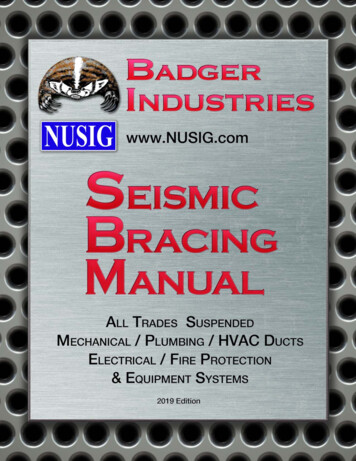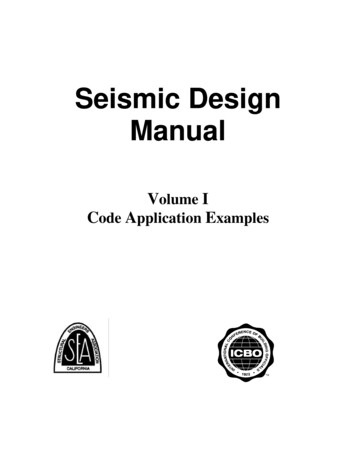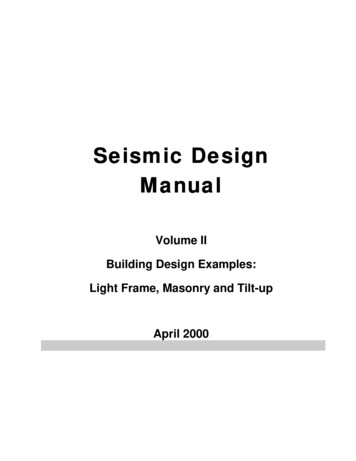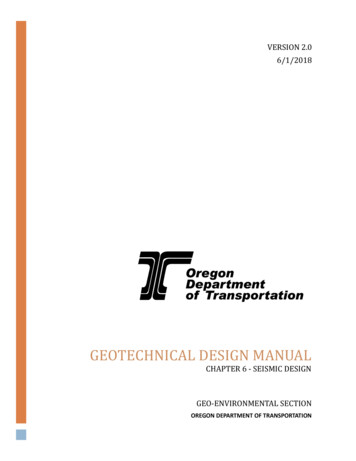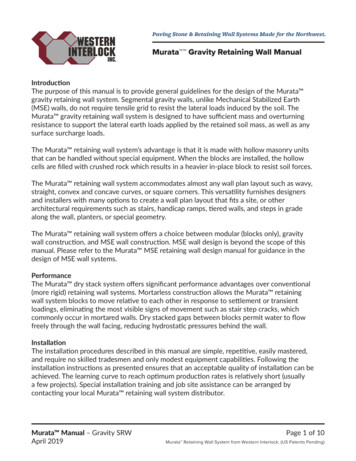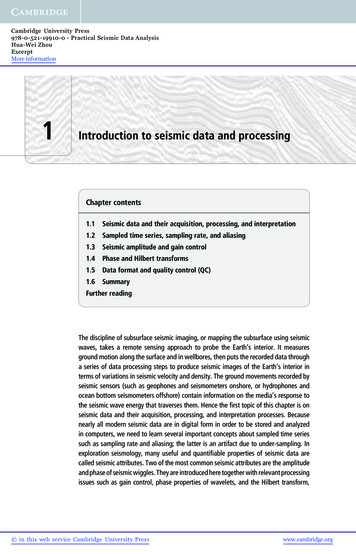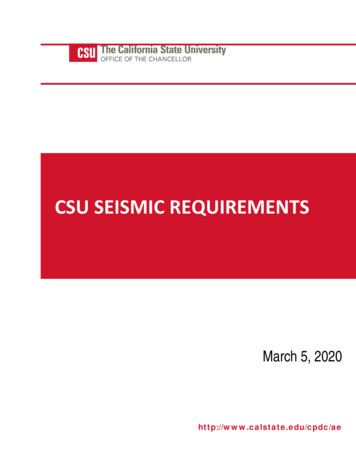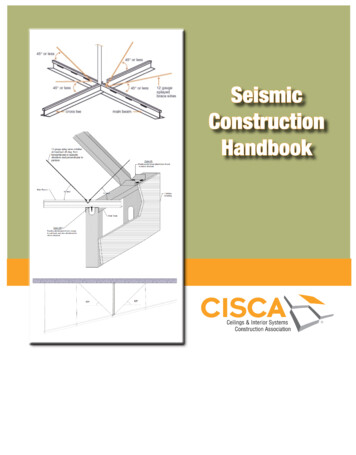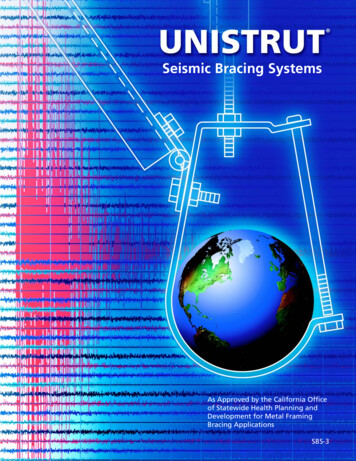
Transcription
Seismic Installation Manualwww.grippleseismic.comCalifornia Office of StatewideHealth Planning & DevelopmentOPA-2123-10
This manual provides the design strength capacities and installationguidelines for the Gripple Seismic Bracing System for use in thedesign of an overall bracing system for suspended nonstructuralcomponents, equipment, and systems for compliance with theCalifornia Building Code 2010 Edition.2
Contents / Page NumberSection 1: Introduction1.1 Introduction 41.2 Gripple Seismic Kit Contents51.3 Scope - System Strengths6-81.4 Description of Bracing Assemblies1.4.1 Transverse 91.4.2 Longitudinal 101.4.3 ‘4-Way’ 111.5 Brace Spacing Guidelines12-141.6 Bracing System Design Guidelines15-17Section 2: Seismic Bracing Kit and Components Overview2.1 Kit Contents 182.2 Fastener & Eyelet192.3 Brackets 20Section 3: Seismic Brace Installation3.1 Basic Brace Layout213.2 Seismic Fastener Installation223.3 Seismic Bracket Installation3.3.1 Retrofit Bracket Installation233.3.2 Bracket Stacking Installation243.4 Washers 253.5 Support Rod Stiffeners26-27Section 4: Brace Anchor / Attachment Installation4.1 Basic Guidelines for Concrete Structures4.1.1 Concrete Wall 284.1.2 Concrete Ceiling/Roof294.1.3 Concrete Over Metal Decking30-324.1.4 Concrete Block Wall334.2 Bar Joists4.2.1 Transverse or Longitudinal344.2.2 ‘4-Way’354.3 Attachment Design4.3.1 Selected Structural AttachmentDesign Strengths4.3.2 Normal Weight Concrete4.3.3 Concrete-Filled Metal Deck4.3.4 Concrete Block4.3.5 Anchor Prying Effects36-3738394041Section 5: Bracing Layout Guide5.5 Insulated Pipe & Conduit5.1 Round Ductwork5.5.1 Transverse5.1.1 Transverse 425.5.2 Longitudinal5.1.2 Longitudinal 435.5.3 ‘4-Way’5.1.3 ‘4-Way’ 445.6 Trapeze/Strut Supported Piping or Conduit5.2 Rectangular Ductwork5.6.1 Transverse5.2.1 Transverse 455.6.2 Longitudinal5.2.2 Longitudinal 465.6.3 ‘4-Way’5.2.3 ‘4 Way’ 475.7 Electrical Cable/Ladder/Basket Tray5.3 Flat or Oval Ductwork5.7.1 Transverse5.3.1 Transverse 48SIGNATURE REQ’D5.7.2 Longitudinal5.3.2 Longitudinal 495.7.3 ‘4-Way’5.3.3 ‘4-Way’ 505.8 Rectangular Units of Equipment5.4 Un-Insulated Pipe & Conduit5.8.1 ‘4-Way’5.4.1 Transverse 51T5.8.2 Linear ‘4-Way’5.4.2 Longitudinal 525.4.3 ‘4-Way’ 5354555657585960616263643
1.1 IntroductionGripple Seismic Bracing Systems are specifically designed and engineered to brace and secure suspendednonstructural equipment (VAV boxes, fans, unit heaters, small in-line pumps, etc.) and components (HVACduct, conduit/cable tray, and piping) within a building or structure to minimize earthquake damage.Gripple Seismic Bracing systems are ideal for use on nonstructural components and equipment requiringseismic design, such as in essential facilities that are required for emergency operations in the aftermath of anearthquake.This pre-approval conforms to the 2010 California Building Code. Detailed in this manual are bracing designcapacities and installation guidelines for a variety of nonstructural components, equipment, and systems.Actual bracing requirements for some sites may vary from these guidelines, and these site-specific bracinginstallations are not limited to the guidelines detailed here. However, any deviations from the guidelines withinthis manual shall be designed and justified by the Registered Design Professional and submitted for approvalto the Authority Having Jurisdiction for the project.The services of a Registered Design Professional is required to determine the seismic demand forces, requiredbracing, spacing, and anchorage attachment of the bracing to the structure in accordance with these guidelinesand the 2010 California Building Code (CBC) design provisions and conditions for the project.It is the responsibility of the Structural Engineer of Record for the project/site to ensure that the existingstructure is capable of withstanding the full loads that may be induced by the braced equipment and Seismicattachments.Please note that this manual does not replace code-required industry standard practices. Gripple SeismicBracing systems, designed as per the guidelines outlined in this manual, do not guarantee adequacy of thecomponent installation. It is the responsibility of the Registered Design Professional for the nonstructuralcomponent or system to ensure adequacy of the design, placement of the seismic bracing kits, and installationin accordance with the 2010 CBC.Michael J. GriffinProfessional EngineerCalifornia No. 38184DATE2/12/13.Disclaimer:Neither Michael J. Griffin nor Gripple are the Structural or Registered Design Professional. The stability and adequacy of the structuralelements, nonstructural components or seismic sway braces, hangers, brackets, bolting, anchorage and any other required attachmentsare the responsibility of the Registered Design Professional, or the Structural Engineer of Record for the Facility or Project. Any additionalor supplementary members required to ensure the adequacy or stability of the structures the seismic sway bracing attaches to are notwithin the scope of this manual/document.Gripple warrants that the Gripple Seismic Bracing Systems will achieve the applicable design strengths published if installed in accordancewith the guidelines contained in this manual. Gripple disclaims any and all other express or implied warranties of fitness for any general orparticular application. Anyone making use of this manual does so at their own risk, and assumes any and all liability resulting from suchuse.4
1.2 Introduction / Gripple Seismic Kit ContentsGrippleSeismicKit ftStandardRetrofit20ftStandardRetrofitRange of tStandardUnderstanding GrippleSeismic CodesCable SizeGS10 5/64”GS12 1/8”GS19 3/16”Cable Length10, 15 or 20ftGS1915ftRetrofitEnd FittingE 45º EyeletS Standard BracketStandard20ftGS12-10E4-S4End Fitting Size4 3/8”5 1/2”6 5/8”8 3/4”Style of Loose BracketS Standard BracketR Retrofit BracketLoose BracketSize4 3/8”5 1/2”6 5/8”8 S6-R6GS19-20S8-R85
1.3 Introduction / Scope - System StrengthsBreak strength certified,pre-stretched GrippleSeismic cable braceHanger rod with stiffenerSee Section 3.5AxialTensionLoadAnchorage to structureSee Section 4See Section 3 for endbracket installationBrace angle0 30º - 60ºAttachment to equipmentSee Section 5See Section 3 for end bracketinstallationFhGripple Seismic fastener See Section 3 for installationGripple System Seismic Design Strengths - Axial Tension LoadGrippleSeismic KitCableOrientation(from horiz.) 1GS10300-600GS12GS19300-600300-600SeismicBracket 2Rod, Component,or StructureAttachment Size 3Minimum WasherRequirements SS6GSS8GSR4GSR5GSR6GSR83/8” dia.3/8” dia.1/2” dia.3/8” dia.1/2” dia.3/8” dia.3/8” dia.1/2” dia.3/8” dia.1/2” dia.3/8” dia.1/2” dia.5/8” dia.3/4” dia.3/8” dia.1/2” dia.5/8” dia.3/4” sion(50 kg) 5XXXXXXXXAllowable Capacity(ASD) 6, 7 lbsDesign Strength(LRFD) 6, 7 lbs2253506751,0501,4002,1001. Orientation is the brace angle, as measured from horizontal. Permitted installation angle for the Gripple Seismic Brace System ranges from 30º to 60º.2. Seismic brackets are named using the following conventions: E eyelet, S standard bracket, R retrofit bracket. Attachment size for each bracket is provided in the‘Rod, Component, or Structure Attachment Size’ column.3. Capacity of the vertical rod/component attachment/structural attachment anchorage to be designed by the applicable nonstructural component Registered DesignProfessional. See Section 3.5 for selected design capacities for vertical components.4. Minimum washer type approved for use with each system / bracket combination are noted in the table. Standard standard round washer; Square square washermeasuring 1-5/8” x 1/4” thick (standard square flat plate washer for strut); Oversized oversized rectangular or slotted washer measuring 2-1/4” x 2” x 1/4” thick(provided by Gripple, to be used with ALL GS19 retrofit brackets at brace angles between 30-60º. Washers are prioritized from lowest to highest capacity as: standard,square, then oversized. The next highest capacity may be used from the minimum shown in the Table. In no cases is a lower capacity washer allowed from theminimum shown. Note that the washer must be sized to match the corresponding anchor / rod diameter. See Section 3.4.5. Pretensioning (to a minimum of 50kg - 110 lbs) is accomplished with the calibrated Gripple supplied Pretensioning Tool.6. The reported seismic allowable capacities / design strengths represent the lowest capacity / strength based on established deformation and force requirements forall the system components (cable, brackets, fittings, fasteners) based on testing, excluding component and structural attachment. Refer to Section 4 for selectedattachment design strengths.7. System seismic allowable capacities / design strength values are to be used with the seismic demands as calculated using the applicable code provisions (CBC 2010 &ASCE/SEI 7-05).GRIPPLE 1611 EMILY LANEAURORA, ILLINOIS60502, U.S.A .T: 001.630.406.0600F: 001.800.654.0689 GRIPPLE 2013www.grippleseismic.comPAGE62/12/13
1.3 Introduction / Scope - System Strengths (continued)The following components of the Gripple Seismic Bracing System are addressed by this OPA:1.2.3.4.5.6.Gripple brackets at the pipe / nonstructural component attachment.Gripple cable brace component.Gripple cable fastener component.Gripple bracket at the building attachment.Gripple bracket attachment (anchorage) to the building structure.Load path member used in conjunction with the cable brace system(compression strut at rod hanger supports).The following defines the components or elements that are NOT addressed by this OPA, but are required to beaddressed by the applicable Registered Design Professional addressing the nonstructural component seismic design /qualification:1. Nonstructural component (pipe, conduit, bus duct, HVAC duct, fan, VAV box, unit heater, etc.) seismicqualification.2. Nonstructural component gravity support system (rod hanger, trapeze support, assembly, etc.) design.3. Attachment (anchorage) of the nonstructural component gravity support system to the building structure.4. Vibration isolation components of supports of suspended nonstructural components required for operationalconsiderations.The Gripple seismic system design strengths or capacities are summarized in Table 1. The system allowable capacities(ASD) or design strengths (LRFD) shall equal or exceed the calculated seismic loads for the nonstructural componentor system of interest using the seismic design provisions from the 2010 California Building Code and ASCE/SEI 7-05,Chapter 13 design standards.Installation parameters identified for the Gripple Seismic Cable Bracing System include the following:1. The Gripple Seismic Cable Bracing systems are confined to the following component combinations:GS10 (5/64” Cable and GS10 Fastener):- GSE4 Eyelet- GSS4 and GSS5 Standard Brackets- GSR4 and GSR5 Retrofit BracketsGS12 (1/8” Cable and GS12 Fastener):- GSE4 Eyelet- GSS4 and GSS5 Standard Brackets- GSR4 and GSR5 Retrofit BracketsGS19 (3/16” Cable and GS19 Fastener):- GSS4, GSS5, GSS6, and GSS8 Standard Brackets- GSR4, GSR5, GSR6, and GSR8 Retrofit Brackets2. The Gripple Seismic Cable Brace system shall be installed in the range from 300 to 600 from the horizontalwith 450 being the optimum cable angle to coincide with the 450 angle of the eyelet and bracket fittings.3. The brace system shall be attached to the nonstructural component with the Gripple eyelet, GSS, or GSRbracket. Installing the cable system via looping through the trapeze support strut holes is not allowed.GRIPPLE 1611 EMILY LANEAURORA, ILLINOIS60502, U.S.A .T: 001.630.406.0600F: 001.800.654.0689 GRIPPLE 2013www.grippleseismic.comPAGE72/12/13
1.3 Introduction / Scope - System Strengths (continued)4. The brace system shall be anchored to the structural system (building attachment) with anchor bolts, selectedin accordance with Section 4 to this manual or selected and designed by the Registered Design Professionaladdressing the nonstructural component, through the Gripple eyelet or GSS and GSR brackets, or loopedaround a structural member (bar joist or structural beam, etc.) and fastened with a GS fastener.5. A 12” minimum distance between the loop attachment at a component or structural attachment and the GSfastener shall be maintained.6. The tail of the cable shall extend a minimum of 2” beyond the GS fastener.7. Nuts and washers are required at all bracket connections (at the structure and at the component). Standardround washers must be installed at GSE4 bracket attachments. Either standard round washers or square strutwashers (1-5/8” square x 1/4” thick) may be installed with the standard brackets (GSS4, GSS5, GSS6, &GSS8). Standard square strut washers are required for the majority of retrofit bracket conditions; however,oversized square or slotted retrofit washers are required for GS19 systems utilizing retrofit brackets.Additionally, at retrofit brackets used to attach to existing components where no washer is present, anoversized square or slotted washer is required.8. Pretensioning of the GS19 seismic cable brace systems is required. Pretensioning is accomplished using thecalibrated Pretensioning Gripple Tool with the tool set to apply at least 50kg - 110 lbs. Note that all other cablesystems (GS10, GS12) and orientations (30O, 45O, 60O) may be installed hand tight or pretensioned.9. The GS fastener (GS10, GS12, & GS19) locking screws shall be tightened once cable tension has been set.GRIPPLE 1611 EMILY LANEAURORA, ILLINOIS60502, U.S.A .T: 001.630.406.0600F: 001.800.654.0689 GRIPPLE 2013www.grippleseismic.comPAGE82/12/13
1.4.1 Introduction / Transverse Brace Assembly30º- 60º30º- 60ºRun directionHanger rodwith stiffenerAnchorageto structureAnchorageto structureBreak strength certified,pre-stretched GrippleSeismic cable braceBrace angle30º- 60ºGripple Seismic FastenerFhEnd ViewTransverse bracing acts to resist the seismic forces in a plane perpendicular to the run of braced piping, conduit, ductworkor equipment, as shown above. The seismic forces that a transverse brace resists are illustrated by Fh. A vertical forcecan be generated during a seismic event and as such, rod stiffeners may be required to help prevent the hanger rod frombuckling under this upwards force.Ductile Braced Components:For piping, conduit, and equipment connections manufactured from ductile materials, the maximum allowable bracespacing for transverse bracing is typically 40ft; this brace spacing is dependent on component size, seismic force, bracecomponents selected, and the anchorage to the structure.Non-ductile Braced Components:For piping, conduit, and equipment connections manufactured from non-ductile materials, the maximum allowable bracespacing for transverse bracing is typically 20ft; this brace spacing is dependent on component size, seismic force, bracecomponents selected, and the anchorage to the structure.Refer to Section 1.5 for brace location guidelines.GRIPPLE 1611 EMILY LANEAURORA, ILLINOIS60502, U.S.A .T: 001.630.406.0600F: 001.800.654.0689 GRIPPLE 2013www.grippleseismic.comPAGE92/12/13
1.4.2 Introduction / Longitudinal Brace Assembly30º- 60º30º- 60ºRun directionHanger rodwith stiffenerAnchorageto structureAnchorageto structureBreak strength certified,pre-stretched GrippleSeismic cable braceBrace angle30O-60OGripple Seismic fastenerFhSide ViewLongitudinal bracing acts to resist the seismic forces in a plane parallel to the run of braced piping, conduit, ductwork orequipment, as shown above. The seismic forces that a longitudinal brace resists are illustrated by Fh. A vertical forcecan be generated during a seismic event and as such, rod stiffeners may be required to help prevent the hanger rod frombuckling under this upwards force.Ductile Braced Components:For piping, conduit, and equipment connections manufactured from ductile materials, the maximum allowable bracespacing for longitudinal bracing is typically 80ft; this brace spacing is dependent on component size, seismic force, bracecomponents selected, and the anchorage to the structure.Non-ductile Braced Components:For piping, conduit, and equipment connections manufactured from non-ductile materials, the maximum allowable bracespacing for longitudinal bracing is typically 40ft; this brace spacing is dependent on component size, seismic force, bracecomponents selected, and the anchorage to the structure.Refer to Section 1.5 for brace location guidelines.GRIPPLE 1611 EMILY LANEAURORA, ILLINOIS60502, U.S.A .T: 001.630.406.0600F: 001.800.654.0689 GRIPPLE 2013www.grippleseismic.comPAGE102/12/13
1.4.3 Introduction / ‘4-Way’ Brace Assembly40º - 50ºHanger rod with stiffenerRun direction30º- 60ºAnchorageto structureAnchorageto structureFhFhAnchorageto structureTop ViewAnchorageto structure4-Way bracing acts to resist the seismic forces of the run of braced piping, conduit, ductwork or equipment, in both thetransverse and longitudinal directions, as shown above. The seismic forces that a 4-Way brace resists are illustrated byFh. A vertical force can be generated during a seismic event and as such, rod stiffeners may be required to help preventthe hanger rod from buckling under this upwards force.Ductile Braced Components:For piping, conduit, and equipment connections manufactured from ductile materials, the maximum allowable bracespacing for 4-Way bracing is typically limited to 80ft, so long as transverse bracing is used in addition, every 40ft; thisbrace spacing is dependent on component size, seismic force, brace components selected, and the anchorage to thestructure.Non-ductile Braced Components:For piping, conduit, and equipment connections manufactured from non-ductile materials, the maximum allowable bracespacing for 4-Way bracing is typically limited to 40ft, so long as transverse bracing is used in addition, every 20ft; thisbrace spacing is dependent on component size, seismic force, brace components selected, and the anchorage to thestructure.Refer to Section 1.5 for brace location guidelines.GRIPPLE 1611 EMILY LANEAURORA, ILLINOIS60502, U.S.A .T: 001.630.406.0600F: 001.800.654.0689 GRIPPLE 2013www.grippleseismic.comPAGE112/12/13
1.5 Introduction / Brace Spacing GuidelinesGripple Seismic Bracing must be installed on the vertical support system comprised of threaded rod (all-thread rod) hangersuspensions, or directly to a suspended individual equipment component.Seismic bracing shall be designed in accordance with:- the guidelines contained in this manual- the applicable building code or local city/county code requirements for seismic design- the engineering drawings and specifications of the specific project requirementsComponent hanger spacing will typically be less than the required spacing of the seismic braces.Typical maximum allowable brace spacing limitsThe maximum allowable brace spacing for piping/conduit/ductwork constructed of ductile materials (e.g. steel, copper, aluminum) are typically:- 40ft for transverse bracing (piping larger than 2½” dia, general conduit and ductwork)- 80ft for longitudinal bracing (piping larger than 2½”, general conduit and ductwork)- 30ft for transverse bracing (piping smaller than 2½” dia)- 60ft for longitudinal bracing (piping smaller than 2½” dia)The maximum allowable brace spacing limits for piping/conduit/ductwork constructed of non-ductile materials (e.g. cast iron, plastic)are typically:- 20ft for transverse bracing- 40ft for longitudinal bracingThe brace spacing could be considerably less than the maximum spacing for a specific run, depending on the seismic demandloads, the size and load capacity of the cable brace system used, and the strength of the structural members/components andstructural anchors which resist the resulting seismic brace forces.Reduced spacing may also be required to prevent:- collisions between the piping/conduit/ductwork/equipment and other non-structural components.- rupture/shearing/slippage of flexible joints between piping/conduit/ductwork and floor/ceiling mounted equipment.Brace size and spacing should not vary considerably along a run to ensure uniform deflection of the piping/conduit/ductworkand uniform loading of the individual braces during a seismic event.1.Transverse4-Way Transverse bracing can be used as longitudinal bracing for anadjacent run (at 90º changes of direction) when the brace islocated less than 24” from the change in direction. Longitudinal/Transverse sway bracing shall also be requiredwithin 24” of every flexible coupling due to differential movementof the pipe or conduit.Maximum longitudinalspacingMaximum transverse spacingLess than24”Maximum transversespacingGRIPPLE 1611 EMILY LANEAURORA, ILLINOIS60502, U.S.A .T: 001.630.406.0600F: 001.800.654.0689 GRIPPLE 2013www.grippleseismic.comPAGE122/12/13
1.5 Introduction / Brace Spacing Guidelines (continued)2.TransverseMaximum transverse spacing4-Way Offset less than24”Piping/conduit/duct run may be considered a continuousrun if the horizontal offset is less than 24”. Otherwise, if theoffset is greater than 24”, each straight segment shall betreated as an independent run and appropriately braced.3.TransverseMaximum transverse spacingLess than 24”1.4-Way2. The minimum bracing required for runs longerthan 5ft is a transverse brace at each end, and alongitudinal brace at one of these two positions.This bracing could be sourced using points 1 and2 above.More than 5ft butless than transversespacingLess than 24”Maximum transverse spacingGRIPPLE 1611 EMILY LANEAURORA, ILLINOIS60502, U.S.A .T: 001.630.406.0600F: 001.800.654.0689 GRIPPLE 2013www.grippleseismic.comPAGE132/12/13
1.5 Introduction / Brace Spacing Guidelines (continued)Max transversespacing4.Less than 24” maxTransverse4-Way4-Way bracesrequired if verticalrun exceeds 3ftLess than24” max Vertical runs must have both transverse and longitudinalbracing, or a 4-Way brace at each end of the verticalrun. These bracing points must be located within 24”of the end of the vertical run, away from the change indirection. 4-way braces shall be provided at the top and bottom ofall pipe risers exceeding 3ft in length.Less than24” maxLess than 24” maxMax transversespacing5.Maximum transverse spacingMaximum transverse spacing4-Way bracedequipmentTransverseLess than 24”4-Way Each unit of equipment connected to a run of piping/conduit/ductwork should be individually and independently braced. Ifrigidly connected to the piping/conduit/ductwork, then the equipment bracing shall also be designed for the tributary piping/conduit/ductwork seismic forces. If the piping/conduit/ductwork is not rigidly connected, i.e. flex joints, then the equipmentbracing cannot be used to brace the adjacent piping/conduit/ductwork and shall be independently braced. Suspended rectangular units of equipment shall be provided with a minimum of one sway brace at each corner (4 totalbraces). See Section 5 for details.GRIPPLE 1611 EMILY LANEAURORA, ILLINOIS60502, U.S.A .T: 001.630.406.0600F: 001.800.654.0689 GRIPPLE 2013www.grippleseismic.comPAGE142/12/13
1.6 Introduction / Bracing System Design GuidelinesGeneral Design Process: Gripple Seismic Bracing SystemThe following provides the general process in designing seismic component bracing using the Gripple Seismic BracingSystem.1. Determine the routing of the distribution system (HVAC duct, cable tray, conduit, etc.) or the location of thesuspended component. The Registered Design Professional shall design the appropriate vertical supports andspacing (refer to Section 3.5).2. Calculate the seismic brace forces using the provisions of the 2010 California Building Code and ASCE 7-05.Parameters required for this calculation include the seismic weight of the component, seismic brace layout(transverse and longitudinal) and spacing, spectral acceleration (SDS), component importance factor, aP & RPfactors, elevation in the building structure, and any other applicable load combinations.3. Select the appropriate Gripple Seismic Cable Brace System based on strength capacities required (Section 1.3).Determine required attachments for the installed condition (eyelet, standard bracket, retrofit bracket, etc.).4. Resolve brace force into component forces (tension & shear) at anchor attachment to the structure. Applyappropriate prying factor from Section 4.3 to anchor demands.5. Select the desired structural attachment and determine the appropriate anchor capacity from Section 4.6. Compare anchor demands (Step 4) and anchor capacities (Step 5) to determine adequacy of selected anchor forthe structural attachment.7. Calculate forces on threaded rod and compare with capacity in Section 3.5 to determine adequacy of rod androd stiffener requirements at brace locations.Registered Design Professional Responsibility:It is the responsibility of the Registered Design Professional in responsible charge to:1. Verify that the nonstructural component or system is seismically qualified in accordance with the CBC 2010.2. Verify that the proper Gripple Brace System is selected to meet the seismic requirements of this OPA.3. Verify that the structure to which the Gripple Seismic Brace is anchored meets the requirements of the applicableanchorage ICC ESR.4. Verify that anchor edge distance and spacing meets the requirements of the applicable ICC ESR.5. Verify that the installation is in conformance with the 2010 CBC and with the details shown in this OPA. Testingof post-installed anchors shall also be performed in accordance with 2010 CBC Section 1916A.7. See Section4.3.1 for anchor testing requirements.GRIPPLE 1611 EMILY LANEAURORA, ILLINOIS60502, U.S.A .T: 001.630.406.0600F: 001.800.654.0689 GRIPPLE 2013www.grippleseismic.comPAGE152/12/13
1.6 Introduction / Bracing System Design Guidelines (continued)OSHPD Requirements:General 1. Pre-approved Gripple Seismic Bracing System and anchor systems may be used for the bracing and anchorage ofpipes, conduits, ducts and suspended nonstructural equipment components. A California Licensed Engineer hasdesigned the pre-approved systems contained in this OPA, along with supporting calculations. Therefore, the preapproved details and calculations are not to be re-reviewed by regional staff. However, each pre-approved systemrequires submittals that must be reviewed and approved by OSHPD.2. Submit plans showing how and where the pre-approved bracing and anchorage systems will be applied to eachapplicable system on a project specific basis. The submittal shall provide details sufficient to verify that the appropriatedetail per the pre-approved details has been selected and applied for each condition and for the actual substrate thatit will be connected/attached to. These plans shall be prepared by the applicable architect or engineer (RegisteredDesign Professional - RDP) dependent upon the nonstructural system (Ref. CAC Section 7-115). The RDP shall providea completely designed bracing and anchorage system in accordance with the pre-approved Gripple Seismic BracingSystem requirements (Items 1-7 General Design Process, and Items 1-5 Registered Design Professional Responsibilitynoted above). The application of the pre-approved requirements and design is not the responsibility of the Inspector ofRecord (IOR), whose responsibility is to inspect only, not design.3. The structural engineer of record (SEOR) for the project shall review and forward the bracing and anchorage plans forplan check with a notation indicating that the plans have been reviewed and they have been found to be in generalconformance with the design of the project (Ref. CBC Section 107.3.4.2). A “shop drawing stamp” is acceptable forcompliance with this requirement.4. Regional staff, on a project specific basis, shall review bracing and anchorage details and supporting calculations thatare not part of a pre-approved system. Review of bracing and anchorage details of this nature do not constitute a preapproval that may be used on other projects without the benefit of plan review.Pre-Approved Pipe, Duct, Conduit and Component Bracing –1. Shop drawings of the support and bracing systems per the pre-approval shall be submitted to the discipline inresponsible charge of the project for review to verify that the details are in conformance with all code requirements.The shop drawings shall be in accordance with ASCE 7-05 Section 13.6 as modified by the CBC 2010 Section1615A.a. The Structural Engineer of Record (SEOR) shall verify that the supporting structure is adequate for the loadsimposed on it by the supports and braces installed per the pre-approval in addition to all other loads.b. The SEOR shall forward the bracing and anchorage plans (including approved change orders forsupplementary framing where required)
Gripple Seismic Bracing systems are ideal for use on nonstructural components and equipment requiring seismic design, such as in essential facilities that are required for emergency operations in the aftermath of an earthquake. This pre-approval conforms to the 2010 California Building Code. De
